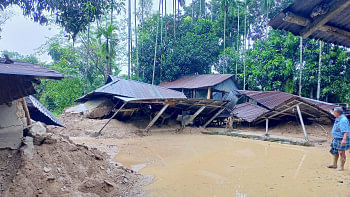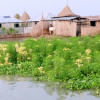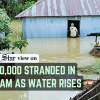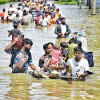Floods in the north matter too

This year, severe flash floods have affected people in Mymensingh, Netrokona and Sherpur districts, killing at least 10 people in the last seven days. However, the extent of government and private support in terms of rescue and relief operations has not been as prominent as it was during the August flood that occurred in the southeastern region. The flood in Rangpur, Kurigram and Lalmonirhat districts in the Teesta basin earlier in September also saw a similar sort of passivity.
It is undeniable that the flood in the southeastern region in August was unprecedented, and the way people from all walks of life extended their support was unique and rare. After Sheikh Hasina's ouster, the entire nation felt a great wave of unity. Dhaka University's Teacher and Student Centre (TSC) premises turned into a relief repository. Thousands of volunteers from all over the country, even from the northern districts, went to Feni, Noakhali and Cumilla to rescue flood-affected people. Government and private employees, military personnel, civilians, various religious institutions, and even school and college teachers contributed one day's salary to the government's relief fund. The government also launched rescue and relief operations and opened the Chief Adviser's Relief Fund immediately.
People in the northern districts, where floods occur several times every year, were watching the reports on the abovementioned incidents on the mainstream news media as well as social media. Watching these, they probably wondered why they too were not getting support to this extent when there is a flood in the northern region. Many people on social media also raised this question: is the flood in the north not worthy of empathy? Do floods not cause the same level of misery to the residents of the northern region?
Before addressing these questions, let us analyse why so many people from all over the country responded to the August flood and why the government was so proactive.
First of all, the severe flooding in Feni-Cumilla was one of the worst floods in the history of Bangladesh. The floodwater rose to the level of a two-storey building in many places—something people could not foresee. As a result, many were left trapped. They posted audio and video footage of their woes on social media and pleaded to be rescued.
Another factor about the southeastern region that made a difference is the literacy rate, which is much higher than that in the northern region. Financially, people in the south are far better off compared to the north. In every family from the southern districts, one of two members live abroad and send money earned in foreign currency. They have good communication with Dhaka. They could quickly broadcast the dangerous situation they were facing on social media and draw the attention of the news media, government, and general people.
On the other hand, floods in the north occur several times a year. Sometimes it is severe, sometimes not so much. Mainly people living in the Teesta, Brahmaputra and Jamuna river basins are affected by floods, which destroy houses, livestock, fish and also croplands. Over the years, thousands of people have lost their homes to river erosion. There have been instances where river erosion forced a 70-year-old person in the northern region to relocate their home 30-40 times through their lifetime.
People in the river basins of the north are mostly poor and often work as day labourers, farmers, herders and fishers. As a result, if they lose their homes, jobs, domestic animals and crops, they become destitute. Every year, a substantial amount of money is needed to shift their homestead to another location or to build a completely new house. Therefore, they usually have no savings.
In case of floods, the allocation from the Ministry of Disaster Management and Relief comes at a snail's pace. Then the local administration distributes the allocated rice and money among the flood victims through the local upazila administrations. No matter how severe and prolonged the flood is, the weight of a flood relief package does not exceed 10-15kg. Irregularity in relief distribution often deprives some flood victims of the relief. In the last 15 years, many elected upazila chairpersons, who were from the Awami League, distributed relief among their relatives instead of the flood-affected people.
Besides, it takes three to four hours to reach some of the remote chars in Gaibandha and Kurigram by boat as there is no alternative modes of transport. As a result, government and private relief materials are often distributed in the chars located near the river banks, where it is easier to take good photographs of relief distribution for media coverage.
In 2017 and 2019, there were severe floods in the northern districts. However, according to a 2019 report by Transparency International Bangladesh (TIB), the cash and rice the district administration distributed as relief among the flood-affected people were inadequate.
Not just floods, thousands of people in the north also lose their homes to river erosion and become destitute every year, getting nothing from the government for rehabilitation. In the past, only one bundle of tin was given to each erosion-affected family, that too if they got chosen and were very close to the local ruling party leaders/activists.
It is a known fact that there is a development disparity between the northern and southern parts of the country. During the 15 long years of Awami League regime, most megaprojects have been implemented in the southern region. While places in the south including Dhaka are becoming uninhabitable due to over and unplanned development, the lack of development initiatives in the north is driving the northerners to flock to the big cities in the south, including the capital, to get work. What can be a greater example of discrimination than this?
This discrimination cannot be allowed to continue for generations. If the people in the north living in river-erosion and flood-prone areas are asked what help they need, they will not ask for relief. They want embankments and the lives of their rivers back so that flooding does not upend their lives every year, and the interim government should understand it.
The discriminations between the north and the south have now come to the fore. The people of northern districts—the victims of years of discrimination—have woken up and raised their voices. The interim government, which emerged from an anti-discrimination movement, should listen to them.
The pattern of natural disasters has changed because of climate change. The government should revise its climate change policies and prioritise permanent solutions not just for the south, but for the north, too. Proper river-dredging can free lakhs of people in the northern region from floods, river erosion, and the clutches of destitution.
Mostafa Shabuj is a journalist at The Daily Star.
Views expressed in this article are the author's own.
Follow The Daily Star Opinion on Facebook for the latest opinions, commentaries and analyses by experts and professionals. To contribute your article or letter to The Daily Star Opinion, see our guidelines for submission.

 For all latest news, follow The Daily Star's Google News channel.
For all latest news, follow The Daily Star's Google News channel. 











Comments